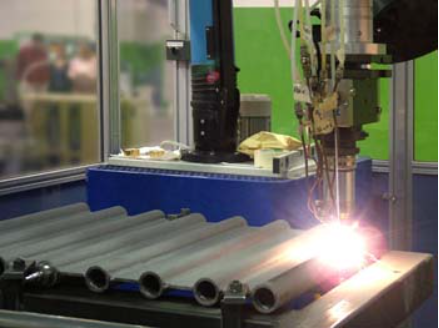

current position:Information and data>Plasma Transferred Arc Welding
Introduction Definition:
The English abbreviation of plasma transfer arc surfacing is PTA. It uses the plasma generated between the tungsten electrode of the welding torch as the negative electrode of the current and the substrate as the anode of the current as heat energy, and transfers the heat energy to the workpiece to be welded. Surfacing process in which it is melted and deposited on the surface of the workpiece to be welded.
Technical advantages:
The most significant advantage of plasma surfacing welding is that its heat affected zone is small, the thermal influence on the substrate is small, and the dilution rate is low, so that the workpiece is less deformed during the welding process; Engaged in delicate welding operations, it can weld very thin workpieces; third, the arc column has high temperature, high energy density, concentration, strong penetration ability, high-speed welding, and high productivity. also,
1. The cladding alloy layer and the workpiece matrix are metallurgically bonded, and the bonding strength is high;
2. The cladding speed of surfacing welding is fast and the dilution rate is low; the dilution rate of plasma arc surfacing welding can be controlled at 5% to 10%, or lower.
3. The surfacing layer is dense in structure and beautiful in shape; the surfacing process is easy to realize mechanization and automation;
4. Plasma surfacing welding can be performed directly on the surface of rusted and oily metal parts without complicated pretreatment process;
5. Compared with other plasma spray welding, the equipment is simple in structure, energy saving, easy to operate, and easy to maintain;
6. The plasma arc temperature is high, the energy is concentrated, the stability is good, and the residual stress and deformation caused on the workpiece are small.
7. Good controllability. The arc parameters such as the atmosphere and temperature of the plasma arc can be adjusted by changing the power, the type of gas, the flow rate and the structure size of the nozzle, so as to achieve efficient automatic production and improve labor productivity.
Fundamental:
Plasma powder surfacing uses the plasma arc as the heat source, and the high temperature generated by the plasma arc is used to rapidly heat the alloy powder and the surface of the substrate to melt, mix, diffuse and solidify together. After the plasma beam leaves, it is self-excited and cooled to form a layer of high-performance alloy. layer, so as to realize the surfacing process of strengthening and hardening of the surface of the parts. Because the plasma arc has high arc temperature, high heat transfer rate, good stability, and strong controllability of penetration depth, by adjusting the relevant surfacing parameters, the surfacing can be adjusted. The thickness, width and hardness of the welding layer can be freely adjusted within a certain range. After plasma powder surfacing, a fusion interface is formed between the base material and the surfacing material, and the bonding strength is high; the surfacing layer has a dense structure, good corrosion resistance and wear resistance; the dilution of the base material and the surfacing material is reduced, and the material properties change little; Using powder as a surfacing material can improve the selectivity of alloy design, especially the refractory material can be surfacing smoothly, and the wear resistance, high temperature resistance and corrosion resistance of the workpiece can be improved.
Therefore, plasma surfacing can be used not only to repair the failure parts of materials due to service, but also to strengthen the surface of materials or parts, the purpose of which is to prolong the service life of parts, save valuable materials and reduce manufacturing costs.
Application range:
Plasma arc welding can be widely used in petroleum, chemical, engineering machinery, mining machinery, industrial machinery (screw, screw, shaft roller, etc.), valves and other industries, such as various valve sealing surfaces (conventional butterfly valves, ball valves, gate valves, etc.) , globe valve, check valve, safety valve, etc.) wear-resistant surfacing welding, as well as the repair of oil drill pipes, bearings, shafts, rolls after wear, etc., its application prospects are very broad.
 Material deposition on boiler tubes with PTA
Material deposition on boiler tubes with PTA
Hot information

